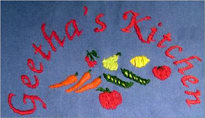Neyyappams (pronounced "Nay-up-pums") are classic South Indian sweet spherical fritters which often include ripe bananas and constitute an integral part of many celebrations. The well-loved appams are made for birth ceremonies, memorial ceremonies, various holidays, or simply as a special snack.
Appams are made in a special pan called 'appa karai' or 'paniyaram' pan in Tamil and is similar to the Scandinavian aebleskiver pan, Japanese takoyaki pan, or the Thai Kanom Krok pan which gives them their characteristic spherical shape but can also be made without any special equipment. It is worth the investment in this pan since it can be used to make wonderful treats using other muffin and pancake batters for special occasions; I use it to make savory
'Vellai appams' using leftover dosa, idli, and adai batters. The nice thing about this pan is that it won't heat up the whole house like a fired up oven especially during summertime.
Appams are traditionally made with rice; I have added the whole wheat flour and the oat meal because they make the appams a little softer and fluffier. They can be made gluten-free if the whole wheat flour and oatmeal are omitted and dairy-free as well if made with oil instead of the traditional ghee. Sesame oil (but not the Chinese toasted kind) is a good choice as is canola oil. Occasionally I like to add finely chopped apples, canned Jack fruit, etc. in place of the bananas for a variation. For an equally delicious baked version, see
Baked Neyyappam.
 The Last Batch! Appams in the 'appa karai'
The Last Batch! Appams in the 'appa karai'
They got a little overcooked
The rest disappeared before I could take a nice picture
3 Ripe Bananas
11/2 cups Rice Flour
1 cup grated Jaggery or brown sugar
5 pods Cardamom
4 Tbsp grated Coconut (2 Tbsp dessicated)
1/4 tsp Sea Salt
1/2 tsp Baking Powder
1/2 tsp Baking Soda
Water, a few tablespoons
1/4 cup Whole Wheat Flour (omit for gluten-free)
1/4 cup Oat Meal flakes(omit for gluten-free)
1/4 cup Ghee or Oil (not Olive) for cooking
Method:Peel the bananas and place in a large mixing bowl; mash well.
Peel the cardamom pods and discard the shells. Grind the seeds finely with a pinch of sugar using a mortar and pestle; add the ground cardamom to the bananas.
Add jaggery/brown sugar and mix well.
Mix together the rice flour, salt, whole wheat flour, coconut, and oats. If you are not using the whole wheat flour or oats, add 2 tsp corn starch.
Stir in the dry mixture into the bananas with just enough water - add a tablespoon at a time - to make a thick batter. Allow the batter to rest covered for an hour or even overnight so the flours can hydrate well.
Mix the baking soda and powder into the batter just before cooking.
Coat the 'appa karai' lightly with a little oil or a cooking oil spray and heat over moderate heat.
Test the pan by dropping a tiny bit of batter; if it sizzles, pan is ready. Pour about 1/3 teaspoon of ghee into each indentation, and fill each 3/4ths full with the batter - if no wheat or oats are used, the batter will not rise very much during cooking.
Keep the heat low to medium so the batter cooks slowly; adjust the heat as necessary.
When the edges change color and the bottom has browned, loosen edges carefully with a skewer or a small spoon and turn them over to cook the other side.
When the appams turn a rich brown or are plum colored with no uncooked batter inside (check by inserting a skewer through an appam), remove them and set aside.
Repeat the steps above to cook the rest of the batter.
Serve hot, warm, or at room temperature. Although they need no further adornments, sometimes they are dusted with powdered sugar or rolled in granulated sugar before serving.
Appams will last about 3 days at room temperature; freeze in freezable containers or zipper bags for longer storage and thaw out and warm as necessary.
NOTE: If you do not have the special pan, the batter can be cooked in a skillet. Pour small spoonfuls and cook over low/moderate heat with a few drops of ghee/oil; flip over and cook both sides until nicely browned. Although these will be shaped like pancakes rather than spheres, they will taste lovely still. Alternately, they can be deep-fried by dropping small tablespoonfuls of the batter in the hot ghee/oil. An egg poacher will work also if you have one.











